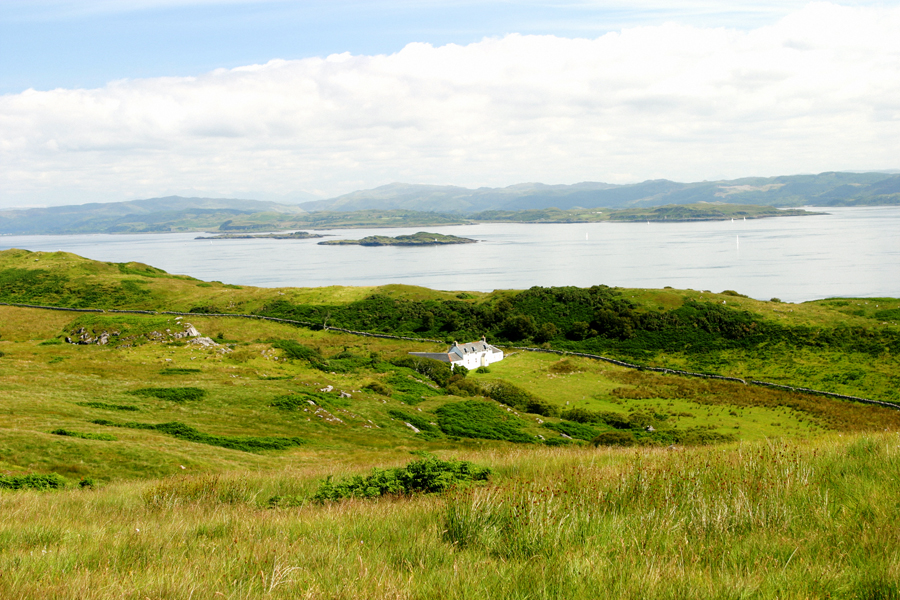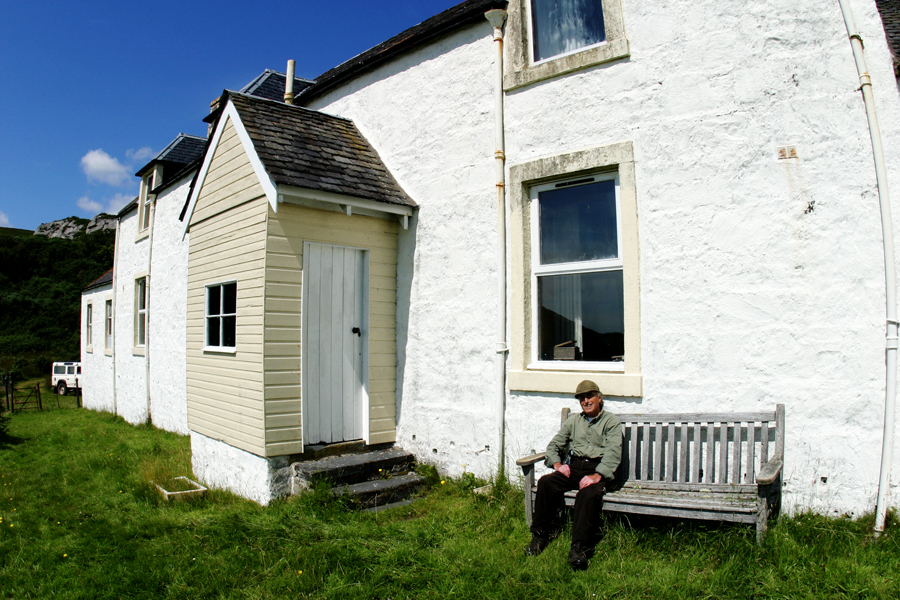We drive for almost an hour along the perilous eastern coast of Jura along a gnarly track, known as “The Long Road,” that has even Charles holding his breath from time to time as the car dances on the edge of one precipice after another out over the sea. Finally we come to the end of the paved road and a gate with a sign forbidding vehicles to venture any farther. Waiting for us on the other side of the gate, leaning against a very beat-up and muddy Land Rover, is Mike Richardson.
“I’ve got to put the bloody sign up to keep igits from taking their rental cars up here,” says Richardson, who will turn 74 in September. “There’s no way they can make it on this road and then I end up having to tow them out.”
The road Richardson refers to is really nothing more that a nasty rough track full of gouged holes a foot or more deep and grass knee-high in places. As we bounce along at 5 miles per hour, Richardson says, “This road is exactly the way it was when George drove his Army BSA motorbike over it 60 years ago. In fact, it might have been better back then.”
The George he is referring to is George Orwell, who came to Jura in 1946 to write his last novel, a book with the working title The Last Man in Europe (which ended up being published as 1984). According to Richardson, Orwell was looking to get as far away from civilization as possible—which is why he picked the wild and unpopulated stretch along Jura’s eastern coast.
“He was a wounded animal looking for someplace to hide,” says Richardson of the author and war correspondant, one of the first journalists to enter the German concentration camp at Bergen-Belsen. “What he saw there made him lose faith in mankind. He couldn’t comprehend the horror. And shortly thereafter he wife, Eileen, died, quite suddenly after a botched operation, and he was quite ill from the tuberculosis that would eventually claim his life at the age of 46 in 1950. So he was a man at the end of his rope, in a way—a bit of the last man in Europe himself as he saw it.”
After about 40 minutes or so we make it the five miles to Barnhill, the old white stone house built in the 1850s, where Orwell lived from May 1946 to January 1949. Richardson takes me upstairs to the bedroom just above the kitchen where Orwell spent most of his time at Barnhill hammering away on his typewriter.
“It was his bedroom,” Richardson says as I look around at the cramped space, “but he didn’t sleep here. He preferred sleeping in an army tent in the garden. Thought the fresh air would do him good. More likely it made things worse.”
Later we sit on an old wooden bench in front of Orwell’s house looking out at the stone field walls, probably erected during the Bronze Age some 3,000 years ago, and the cherry trees Orwell planted and the bay from which he launched a 14-foot dinghy and tried to circumnavigate the island only to capsize just up the coast at the treacherous Corryvreckan whirlpool where he almost drowned. Or at least that’s the conventional version of the story. Which Richardson says with a wave of his hand is nonsense.
“Bullocks. He wasn’t anywhere near the Corryvreckan,” he says. “He was with his son and they were headed for a small island along the west coast to collect puffin eggs and when they stepped out of the boat, it capsized and they were stuck on the island for three hours until a fisherman picked them up. That’s the real story.”
Then why, I ask him, do people always talk about Orwell almost drowning at the Corryvreckan whirpool?
Richardson says, “Makes for a better story, I suppose.” He gives me a wink. “And you know how the Scots are with their stories.”
I do.
-
Hi David, I stumbled upon your blog quite by chance and have been browsing through the archive. A lot of interesting reading. I am Scottish but have been living in Sweden for the past 11 years (my husband is Swedish). I was interested to read of your Scottish adventures and have just reached your journey to Jura.
I just wanted to point out that Mike Richardson is mistaken in his account of Orwell’s near-drowning episode.
According to Eric Blair’s (George Orwell’s) niece and nephew who have talked about this in newspaper interviews in Britain, the incident happened at the Corryvreckan whirlpool. His son Richard Blair has also written about it. The article is on the George Orwell Society’s webpage
“His health was not improved by a near-drowning experience that he, along with myself and his nephew and niece, Henry and Lucy Dakin, had in the Gulf of Corrievreckan in June 1947 when I was three. We were returning from a week of camping on the west side of Jura when we ran into trouble in the infamous stretch of water known as the Corrievreckan Whirlpool. We had arrived at this spot when my father realised that he had miscalculated the tidal stream so that instead of calm, manageable water, the tide was still on the flood. The consequence of this situation is that a standing wave is created in the middle of the tide race. This causes the surrounding currents to become extremely confused, giving it the local title of ‘whirlpool’. It was here that we found ourselves in real trouble. The little outboard motor became swamped and died and, unable to re-start it, Henry took to the oars and managed to row us to one of two rocky islets, where he jumped out onto the rocks and taking the mooring line, tried to secure the dinghy. At this point the swell receded and our dinghy rolled back and overturned, throwing father, Lucy and me into the sea beneath the boat. Fortunately I had been sitting on my father’s knee and he was able to pull us both out from under the dinghy. Lucy did the same and we all scrambled onto the rocky islet. Everything in the boat was lost. There was nothing for it but to try to dry ourselves as best we could and wait to be rescued. This might have been a very long wait but fortunately a lobster boat soon came through and took us to safety. My father – being my father – asked the fishermen to drop us off at the nearest access point to our home track, and we walked back to be greeted with the question, “Where have you been?” My father’s reply was that we had been shipwrecked – an understatement if ever there was one.This episode resulted in my father being admitted to hospital at Hairmyres in East Kilbride later in the year as the involuntary swim had done him no favours. Although he recovered sufficiently to return to Barnhill in the Spring of 1948 to continue writing, the effort took its toll and by 1949 he was back in hospital. He never returned to Jura, the place he had grown to love.”
Since it is now 2013, you may know this information already.
Anyhow, many thanks for your interesting postings and greetings from the North Pole.
Shirley -
Thanks so much for this blog. I was trying to find directions to the house…now I know I don’t want to be one of the idgits in a rental car. ha ha. Really enjoyed the read and appreciate the info.
Comments are now closed.



4 comments